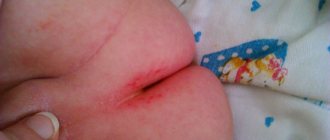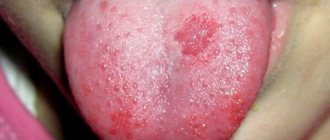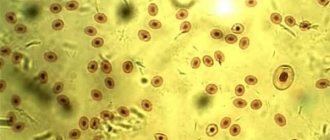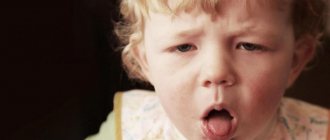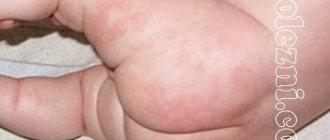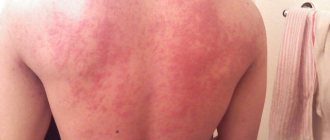General concept and characteristics
A bruise is formed when the walls of blood vessels and capillaries are destroyed during injuries and bruises , resulting in blood accumulating under the skin, dissolving over time.
The bruise is a subcutaneous type of hematoma. At the beginning of its appearance, it is colored dark purple or blue. As it dissolves, the color changes.
This is due to the breakdown of blood hemoglobin into pigments. For example, biliverdin is responsible for the green color of the hematoma, and bilirubin is responsible for the yellow color.
Bruises of a small area (up to 1 cm) are called petichia , and larger ones are called bruises .
Cause: Autoimmune disease
Bruises on a child's legs can be caused by Henoch-Schönlein disease. This disease is characterized by the fact that the wall of blood vessels is perceived by the immune system as an “enemy.” The body begins to produce substances that try to destroy it. The walls of blood vessels gradually become thinner, their fragility and permeability increase. In this regard, formed elements and part of the blood are released into the surrounding tissues. This disease is easily confused with vitamin deficiency, but there are distinctive signs:
- Hematomas appear throughout the body, not just on the legs.
- The leak is regular in shape and rises above healthy tissue. Doesn't disappear when pressed.
- The spots appear symmetrically (in the area of the ankle joints, shins, knees).
- After hematomas appear, large joints begin to hurt.
- Before the spots appear, the child may experience abdominal pain and vomiting. After a couple of days, these symptoms disappear.
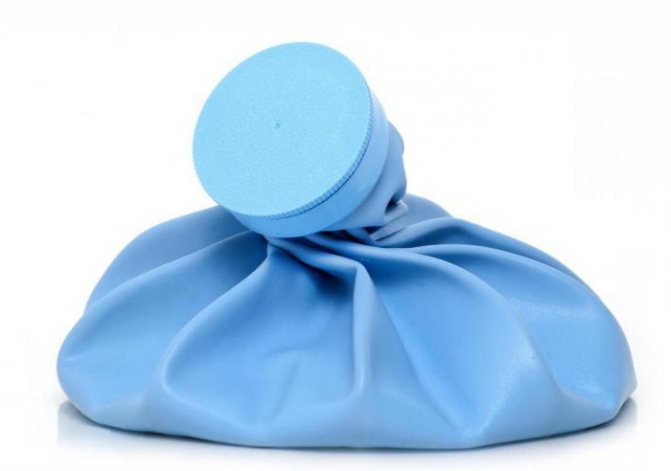
Causes
The most common cause of bruises on the legs of children are bruises and falls. Even newborn baby is not immune from this.
But if bruises appear even after light pressure or a light blow to the surface. This indicates problems with the circulatory system, or, more precisely, with the strength of the walls of blood vessels and capillaries.
In children after one year of age, this may be caused by an acute lack of the following vitamins:
- Ascorbic acid (vitamin C), responsible for the elasticity of the walls of arteries, veins and blood vessels.
- Vitamin K, which helps blood clot when the skin is damaged.
- Rutin (vitamin P), which the body is unable to synthesize itself. This vitamin supports the work of ascorbic acid, increasing the elasticity and strength of small capillaries.
And also with a lack of micro- and macroelements :
- calcium, involved in blood clotting processes;
- selenium, which stimulates the immune system;
- cobalt, which renews the body's cells.
In infants, petichiae on legs may appear as a result of a lack of vitamin K, which they have not yet learned to produce on their own.
As a rule, a similar problem occurs immediately after birth (up to 2 weeks), if the baby was not given an injection with this vitamin .
But bruises on the legs can also be a symptom of very serious diseases.
Possible causes of the phenomenon
There are several of them. Some of the reasons that a child develops hematomas on his legs are not dangerous, while others indicate the presence of very serious diseases.
Fragility of vessel walls
This disease manifests itself by the appearance of reddish or bluish-black hematomas on the skin of the legs. A distinctive feature of this disease is that the bruises spread throughout the body.
As a rule, small hematomas appear first as small capillaries burst. Over time, the insidious disease can affect larger vessels.
This condition can lead not only to an increase in the number and area of bruises, but also to the progression of the disease, which can result in internal hemorrhage.
What factors cause the child to have fragile, thinned blood vessels?
- Lack of vitamin C, which helps strengthen the walls of blood vessels. If the body lacks this vitamin, they become looser, which is the reason why they burst;
- Lack of vitamin K, and as a result, reduced blood clotting ability;
- Insufficient amounts of microelements such as cobalt, selenium, and calcium in the body. These substances make the walls of blood vessels elastic and stronger.
Most often, a lot of bruises on the legs due to fragility of blood vessels in a child occur due to poor nutrition.
Hemophilia
This is a rather dangerous disease that is often inherited. There are 3 types of disease - A, B, C.
- The first 2 types are most often transmitted to boys if the maternal grandfather suffers from the same disease.
- As for hemophilia type C, it can be transmitted regardless of the sex of the child. In this case, the disease can be transmitted from both the mother and the father.
When a baby begins to walk, he may develop bruises on his legs if he has this disease, and the lower legs are usually affected.
The disease is also characterized by frequent bleeding from the gastrointestinal tract, gums, nose, etc. Bleeding is also common during medical procedures, in particular during intramuscular injections.
Bleeding also occurs from the larynx. They are very dangerous because they can interfere with breathing.
With this disease, bruises appear on the child’s legs, seemingly for no reason, but they are also quite dangerous, because hematomas can compress arteries and peripheral nerve trunks. All these processes are accompanied by pain.
Thrombocytopenia
This pathology is a decrease in the level of platelets in the blood. Because of this, internal bleeding may occur, and therefore bruises appear, in particular on the legs.
This disease can also be dangerous for the child’s life, as it threatens internal hemorrhage in various organs.
In childhood, one of the most common causes of the development of the disease is the weakening of the body's defenses.
These are the most common causes of hematomas.
- In addition, the phenomenon can be provoked by liver diseases, which are accompanied by intoxication of the body.
- A disruption in the functioning of the central nervous system and endocrine system can also cause a child to develop bruises on his legs for no apparent reason.
What diseases can be caused?
Subcutaneous hematomas on the legs of children, especially numerous ones that form after minor blows, can occur due to the following diseases:
- Hemophilia is a hereditary bleeding disorder. Only boys suffer from it, and girls can only be carriers of the defective gene. This disease is characterized by constantly appearing bruises, including on the legs. And also slow-healing cuts.
- Thrombocytopenia , which is characterized by a low platelet count in the blood.
- Leukemia ( leukemia ) is a disorder of the function of hematopoiesis in the bone marrow.
Infants , is accompanied by bloody stool and vomiting due to spontaneous damage to blood vessels in the body.
How to remove a splinter from a child's finger? Find out about this from our article.
Why do bruises appear?
There are several reasons for the appearance of bruises on the body in children. Some of them are dangerous to the life and health of the patient.
Deficiency of nutrients in the body
Bruises on the legs appear due to a lack of the following substances:
- Vitamin R. The condition is accompanied by a decrease in collagen production, as a result of which the walls of blood vessels become thinner and their permeability increases. Blood seeps into the soft tissues, causing hematomas to form. In addition to the appearance of bruises, there is a change in the child’s behavior, dysfunction of the digestive system (flatulence, loose stools), increased sensitivity of the skin to ultraviolet radiation, and allergic reactions.
- Vitamin C. Deficiency of ascorbic acid increases the fragility of capillaries, which is why small bruises appear on the child’s legs. Associated symptoms include the frequent occurrence of viral infections, chronic fatigue, lethargy, and flaking of the skin. Deficiency of vitamins P and C causes retardation in physical development. Severe deficiency of ascorbic acid leads to the development of scurvy. The disease begins with the appearance of bruises on the body and bleeding gums.
- Vitamin K. With a lack of this substance, blood clotting decreases. Hemorrhages occur with minor injuries to the vascular walls. The child experiences frequent nosebleeds, scratches and cuts do not heal for a long time, the gums become loose and begin to bleed.
Important information: Why a bruise under the eye appeared without a blow and how to remove a hematoma on the upper eyelid
Autoimmune pathology
The following autoimmune diseases contribute to the appearance of bruises on the legs of infants:
- Hemorrhagic vasculitis. This is a severe pathology in which immune complexes accumulate in the vascular walls and cause inflammation. The capillaries become brittle and over time they begin to break down, causing blood to leak into the soft tissue. Malfunction of the immune system occurs against the background of viral and bacterial infections, intoxication of the body, or prolonged use of medications. Vasculitis is indicated by multiple hematomas and swelling of the lower extremities. The disease requires lifelong therapy.
- Autoimmune hepatitis. The pathology is accompanied by the destruction of healthy liver cells and changes in blood composition. The exact causes of the disease are not clear.
- Systemic lupus erythematosus. Chronic autoimmune disease is accompanied by damage to connective tissues, leading to damage to the vascular walls. Bruises on the skin in this case occur at the slightest mechanical impact.
Malfunction of internal organs
Bruises on the body in children appear under the following pathological conditions:
- dysfunction of the cardiovascular system, accompanied by deterioration of blood circulation;
- chronic inflammation of the tonsils;
- kidney diseases, accompanied by the development of intoxication of the body and deterioration of blood quality;
- pathologies of the liver and gall bladder.
Fragility of vascular walls
This disease manifests itself by the appearance of red or dark blue hematomas on the legs of a newborn child. Over time, bruises spread throughout the body.
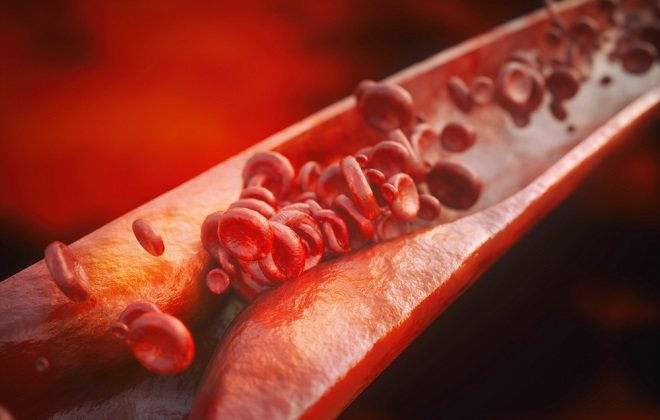
In the early stages of the disease, the spots are small in size and their appearance is associated with ruptured capillaries.
Over time, large veins and arteries become involved in the pathological process.
The size of the hematomas increases, and internal hemorrhages occur.
Important information: How to quickly get rid of a bruise after a blow (contusion) and what to do to remove the hematoma
Hemophilia
Hemophilia is a dangerous genetic disease of the hematopoietic system. There are 3 types of pathology, the first 2 are transmitted through the male line through a generation. The third type of disease occurs regardless of the sex of the child. After children start walking, they have a lot of bruises on their legs.
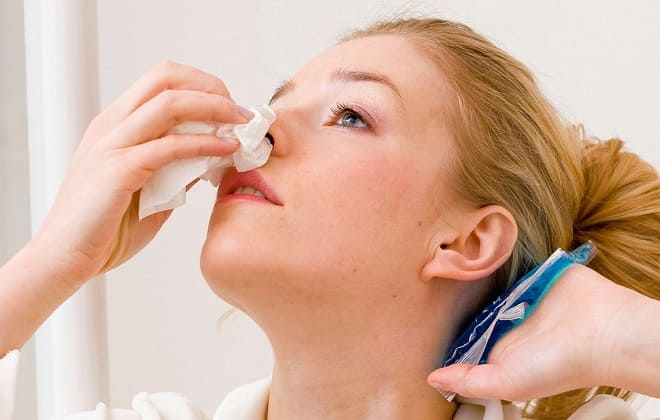
The occurrence of hematomas is accompanied by intestinal, gingival and nasal bleeding. Large seals compress blood vessels and nerve endings, causing pain.
Thrombocytopenia
The disease is accompanied by a decrease in the number of platelets responsible for clotting. Due to blood thinning, multiple bruises appear and bleeding develops. Hemorrhages into internal organs can pose a danger to the child's life.
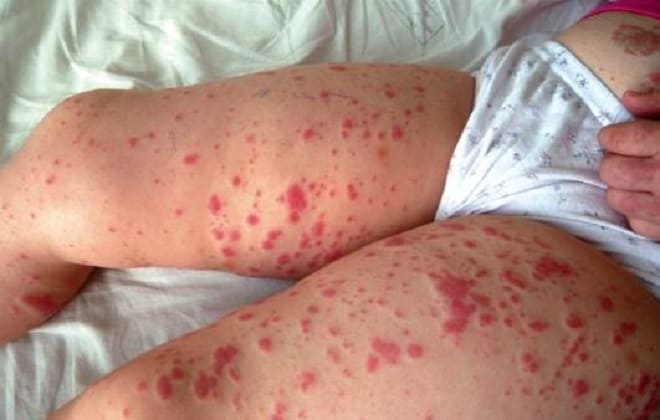
The occurrence of thrombocytopenia is facilitated by weakened immunity. Platelet levels can also decrease in cases of cancer, such as leukemia.
What do bruises for no reason mean?
The unreasonable appearance of hematomas on a child’s legs indicates serious problems with the blood and circulatory system. Lymph flow in the body goes from bottom to top. Therefore, first of all, petichiae and bruises appear on the legs.
A similar phenomenon can be observed not only in the case of thrombocytopenia with an extremely low platelet count, but also against the background of:
- liver diseases (icteric hepatitis, inflammation, acute poisoning, etc.);
- sepsis (general infection of the body), characterized by high fever and loss of consciousness.
Thrombocytopenia, like anemia, can be one of the symptoms of leukemia.
, unreasonable petichiae on the legs can occur due to a lack of vitamin K. This usually happens in the thighs, just below the buttocks. If hypovitaminosis is not treated, the number of bruises begins to increase. They can already appear on the buttocks and back.
Varicose veins are the cause of bruises on the legs
Varicose veins are a well-known vascular disease mostly among women. Occurs due to wearing uncomfortable shoes with too high a heel. Especially if you have to be on your feet all day, also during pregnancy, when there is a lot of stress on your legs. Nowadays, the veins on them become more noticeable. The capillaries crack and the area turns blue.
This disease is determined using ultrasound diagnostics. For the treatment of varicose veins, medications are prescribed for internal strengthening of veins and ointments for external local use. More severe forms require surgery. Modern medicine suggests doing this using a laser, which is safe and painless for the patient. Treatment of varicose veins protects against the formation of blood clots; everyone probably knows that when a blood clot breaks off, death occurs instantly.
Men also suffer from this disease. If the work involves a physically heavy load on the body. Prevention of this disease is a balance between physical activity and rest, wearing comfortable low-heeled shoes, and taking vitamins to strengthen blood vessels. The most important is vitamin C. Having correctly composed your diet, it can be consumed from foods that contain it in large quantities, such as:
Healthy eating is the prevention of many diseases, so you need to approach your diet responsibly and try to follow all nutritional rules.
With liver disease or poor liver function, hematomas can also occur. The liver is a kind of filter in the body and provides it with the necessary enzymes. If such unpleasant symptoms appear, you need to check your liver function using ultrasound diagnostics and special blood tests. These symptoms may be harbingers of the first stage of such a dangerous disease as stage 1 hepatitis. When this disease just begins to develop, it can be cured. An excellent folk remedy for cleansing the liver is a decoction of dried rose hips. By using it in courses, you can prevent such dangerous diseases of the liver and gall bladder.
What to do?
If multiple petichiae appear on the legs of an active child who spends a lot of time among other children, you need to watch them for a couple of weeks .
If the bruises dissolve, turning yellow, then perhaps this is the result of excessive passion for the game.
If the situation worsens (new bruises appear, old ones grow), you should immediately contact a pediatrician for a medical examination.
If multiple small bruises appear, an ambulance should be called for diseases accompanied by high fever , especially if the liver or lymph nodes are affected (mononucleosis, rotavirus infection, hepatitis, etc.).
Reasons for appearance
A hematoma can occur due to a bruise, blow, or compression. Bruises appear during strangulation attempts.
Possible occurrence due to vascular diseases. If their walls are excessively thin and fragile, the integrity of the vessels may be compromised even without physical impact.
Bruises often appear in people suffering from cancer.
A hickey may appear on the neck during foreplay to sexual intercourse. Aggressive kissing often causes damage to the integrity of the vascular walls.
A hematoma can occur due to a bruise, blow, or compression. Bruises appear during strangulation attempts. Possible occurrence due to vascular diseases. If their walls are excessively thin and fragile, the integrity of the vessels may be compromised even without physical impact.
Bruises often appear in people suffering from cancer. A hickey may appear on the neck during foreplay to sexual intercourse. Aggressive kissing often causes damage to the integrity of the vascular walls.
Thrombocytopenia
Thrombocytopenia is a condition characterized by a decrease in the number of platelets. Typically, a decrease in platelet counts occurs throughout life.
Causes: immune processes, mechanical trauma to platelets (surgeries, tumor processes), chemical and radiation damage to the bone marrow (platelets are formed here), replacement of bone marrow with tumor tissue, increased consumption of platelets (thrombosis, disseminated intravascular coagulation syndrome), mutations (Marchiaf-Michelli disease ).
The most striking representative of this group is Werlhof's disease (idiopathic thrombocytopenic purpura). How does it manifest?
The disease is characterized by the appearance of asymmetrical hemorrhages (petechial-spotted type) in the skin (usually on the limbs and anterior surface of the body due to greater trauma), mucous membranes (conjunctiva, oral and nasal mucosa) and bleeding of the gastrointestinal tract, kidneys (blood in the urine ). Very often, hemorrhages occur at injection sites.
It is typical for hemorrhages to occur spontaneously, including at night. Thrombocytopenia differs in that with injuries, as a rule, bleeding that is inadequate to the damage (much more severe) develops.
- Glanzmann's thrombasthenia;
- von Willebrand disease;
- platelet abnormalities and dysfunctions.
How does it manifest? This group of diseases as a whole usually manifests itself as petechial-bruising types of hemorrhages. Petechiae and bruises occur on the skin and mucous membranes, causing nosebleeds and uterine bleeding. In hereditary forms of thrombocytopathies, bruising occurs more often.
Hemorrhages appear quickly with physical impact, for example, pressing on the skin, squeezing the arm with a tonometer cuff, as well as at injection sites. Particularly dangerous are the relatively rare occurrences of hemorrhages in the brain, the harbinger of which can be the appearance of hemorrhages on the skin of the face, neck and upper torso.
Komarovsky's opinion
Popular pediatrician E.O. Komarovsky advises regularly (every four months) to donate blood for a general analysis .
If unreasonable bruises appear on your legs, you can ask for a referral for a coagulogram (advanced clotting test) and a complete biochemical blood test.
The pediatrician reminds that serious blood diseases are accompanied in a child by dizziness, fainting (leukemia), changes in the shape of joints, difficulty moving (hemophilia), and causeless subcutaneous hemorrhages (thrombocytopenia).
If bruises appear in an active child who is feeling well, this may be the result of numerous bruises or a lack of vitamins.
Methods of treating a child
It will take a lot of effort to cure a child. This will require patience on the part of both the child and the parents. Drug therapy will be required, and in extreme cases a blood transfusion will be necessary. Blood transfusions are possible both from direct relatives and using preserved blood. Strict adherence to the diet will also be required, excluding fried foods from the baby’s diet. Nutrition largely shapes the health of children for many years to come.
If parents discover that their child has bruises on their legs, and there is no way to explain the appearance of these hematomas, then they should immediately contact a doctor. Observation by doctors can help prevent negative consequences from this disease in the initial stages of development.
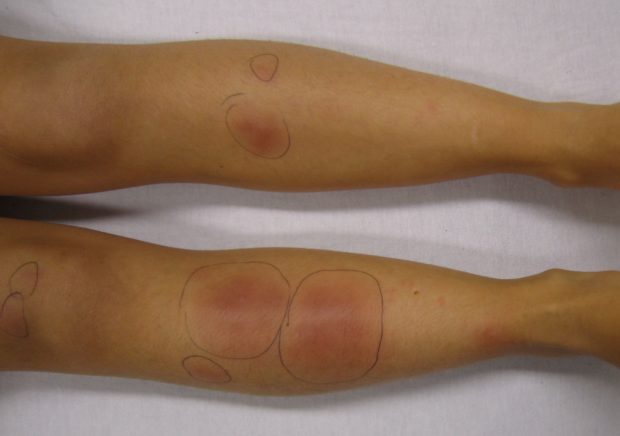
These are not bruises, but erythema nodosum
The first signs that there are problems are:
- difficulties with walking in a child;
- even a light touch to the leg results in a large hematoma;
- after a bruise appears on the lower extremities, the temperature rises sharply in children;
- hematomas form on their own, without any reason.
How to treat?
What can you put on your baby's bruises? Ordinary bruises are treated by first applying cold for 5-10 minutes, and then applying anticoagulants (heparin ointment, troxevasin) twice a day or applying compresses from bodyaga powder for 20 minutes. daily.
Vitamin K deficiency is compensated for by injections of this vitamin. Infants are prescribed 1-2 mg every day.
Hemorrhagic disease in newborn infants is treated using the following method:
- daily vitamin K injections;
- sodium bicarbonate solution (0.5%) 3 times a day, 5 ml (orally);
- thrombin in aminocaproic acid - 5 ml three times a day (orally).
The pediatrician may also prescribe intravenous calcium chloride, calcium gluconate, ascorbic acid, and rutin.
Nutrition during treatment is provided using donor breast milk. If treatment is started on time, the prognosis is favorable.
For thrombocytopenia, only a specialist can prescribe precise treatment depending on the type of disease. As a rule, the child is injected with hormones (prednisolone) and interferon-based drugs in combination with vitamin complexes.
Treatment of leukemia, sepsis and liver diseases are treated in a hospital setting under the supervision of medical personnel.
Characteristic symptoms
The appearance of a hematoma on the neck is accompanied by the following characteristic signs:
- First of all, the damaged area becomes very red. The affected person may feel a nagging pain or a slight burning sensation. In rare cases, itching occurs.
- After a few hours, this area begins to swell, increasing several times its original size.
- The bruise then becomes more pronounced, usually blue with purple, red, or rose edging.
The above three symptoms are safe if they gradually begin to disappear.
Preventive measures
In order for bruises, including those on the legs, to appear less frequently, the child must :
- Strengthen capillaries and blood vessels with cold douches and daily exercises.
- Regularly take multivitamin complexes with vitamin K, ascorbic acid and rutin.
- Do not neglect a scheduled visit to the pediatrician, taking the necessary tests.
Most often, bruises on a child’s legs are the result of his hyperactivity . Parents should be wary if additional symptoms appear - joint deformation, lethargy, immobility, etc. In this case, you need to seek professional help as quickly as possible.
Bruises on legs for no reason , what is it and what to do? Find out about it in the video:
Fighting the phenomenon
If the disease is caused by a lack of vitamins, proper nutrition is necessary to enrich the body with the necessary substances.
To get rid of hematomas, the underlying disease that caused their appearance is treated.
- Thus, to combat thrombocytopenia, drugs that enhance immunity can be used, among other things.
- For hemophilia, blood transfusions are often prescribed.
- If a child develops small bruises on his legs, which often indicate fragility of blood vessels, first of all you need to follow a diet, enrich his diet with vitamins and useful elements.
However, regardless of the treatment tactics for the underlying disease, getting rid of the bruises themselves will take some time. To speed up this process, special ointments are used. Good results in the fight against hematomas on children’s legs are shown by such products as “Troxevasin”, “Indovazin”, “Rescuer”. Almost all of them have a specific smell, but they have a warming effect, which helps resolve bruises. Dolobene in gel form is also used to combat the problem.
Although the effects of these drugs are known, they should not be used without a doctor's prescription.
You can also eliminate bruises on children’s legs using traditional methods, but do not forget that in most cases they are a symptom, therefore, going to the doctor does not cancel their use:
- If the problem is fragility of the blood vessels, ice should be applied to the areas where the bruises have formed. After some time, you need to apply something warm here to relieve inflammation;
- Regardless of what causes the bruises, ointments containing calendula are also used to eliminate them;
- A steamed cabbage leaf, which must be kept on the affected area, relieves inflammation;
- Used to combat the phenomenon of ointments that contain vitamin C;
- Chamomile decoction can also relieve inflammation and promote rapid resorption of the hematoma.
The use of these products must be agreed with a doctor so as not to harm the child’s health.
If the causes of the disease lie in diseases of the blood and blood vessels, it is necessary to ensure that the child does not fall or get bruised. If this does happen, give him first aid immediately.
